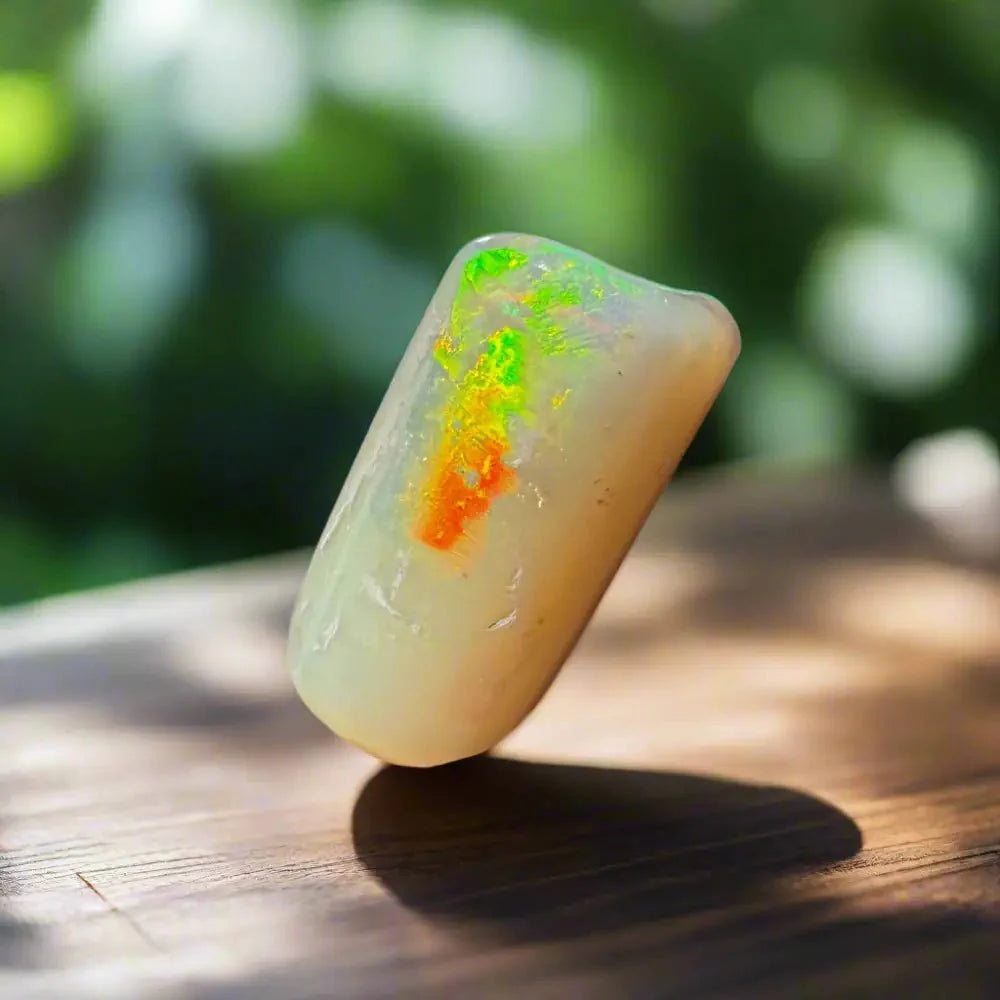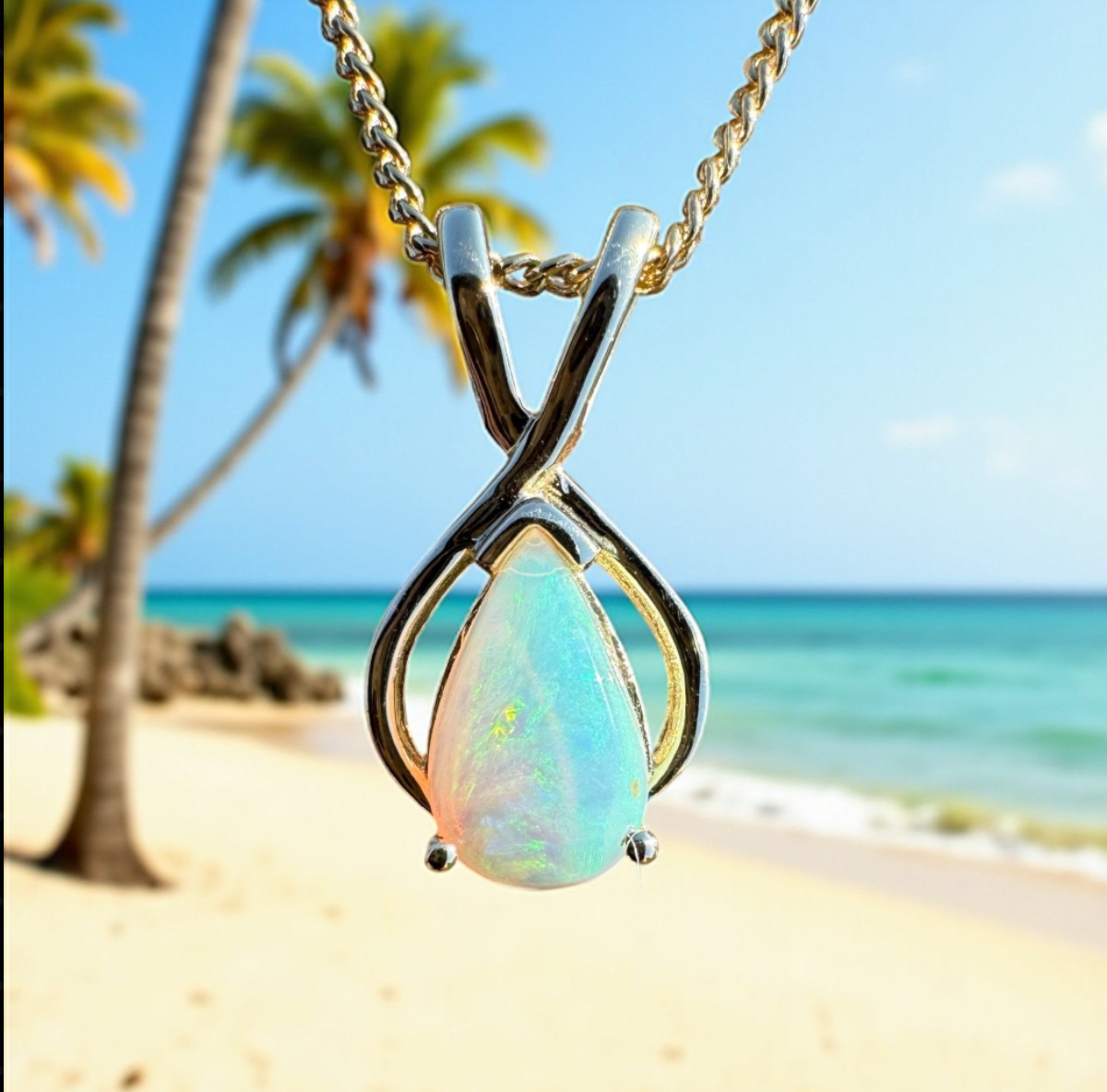Article: The Magic of Opal Fossils: Nature’s Time Capsules

The Magic of Opal Fossils: Nature’s Time Capsules
Hidden deep within the dry heart of Australia lies a secret that even time itself couldn’t erase—ancient fossils, preserved not in stone, but in pure, shimmering opal. Known as opalised fossils, these natural wonders capture a moment millions of years old, frozen forever in brilliant flashes of colour.
From the bones of dinosaurs to delicate marine shells and ancient tree trunks, each opalised fossil tells a story of Australia’s prehistoric past—and reveals just how magical nature’s artistry can be.
A Story Millions of Years in the Making
Around 100 million years ago, much of inland Australia was covered by a vast inland sea known as the Eromanga Sea. As this ancient ocean receded, layers of silica-rich sediment settled into the earth, slowly transforming into the opal fields we know today—Lightning Ridge, Coober Pedy, Andamooka, and Mintabie among them.
When the bones, shells, and wood of ancient creatures were buried in this mineral-rich environment, water carrying dissolved silica began to seep through the ground. Over time, as the water evaporated, silica particles filled every tiny gap within the fossil. With enough pressure and patience from Mother Nature, those silica spheres hardened into opal—perfectly replicating the shape and structure of the original organism.
The result? Fossils with all the texture and detail of the past, but with a luminous play of colour that feels almost otherworldly.
Lightning Ridge: The Home of Opalised Dinosaurs
Nowhere on Earth produces opalised fossils like Lightning Ridge. This iconic town in northern New South Wales is world-famous for its black opals—but hidden among the seams of precious stone are fossils that rewrite history.
Palaeontologists have discovered opalised remains of marine reptiles, molluscs, and even dinosaurs. One of the most famous is the Lightning Ridge opalised pliosaur jaw, gleaming with electric blues and greens. Each discovery reveals clues about an ancient landscape that once teemed with life, now immortalised in gemstone form.
Imagine holding a dinosaur bone that glows with flashes of red and violet—that’s the wonder of Lightning Ridge.
Coober Pedy and Andamooka: Fossilised Sea Life in Colour
While Lightning Ridge is known for vertebrate fossils, South Australia’s Coober Pedy and Andamooka fields yield extraordinary marine fossils—ammonites, belemnites, shells, and even fish bones, all transformed into precious opal.
These stones tell a quieter story—the story of the sea that once covered central Australia. In these shimmering fossils, you can almost see the ancient waves and the creatures that once swam there.
Some fossils display full rainbows of colour, while others glow softly in blues and greens. Collectors treasure them not only for their rarity but also for their scientific and cultural significance. Each opalised fossil is truly one of a kind; once it’s found, there will never be another quite like it.
Nature’s Artistry: How Light Creates Magic
What makes opal fossils so mesmerising is the same phenomenon that gives all opals their beauty—play-of-colour. Tiny silica spheres inside the stone diffract light, splitting it into all the colours of the spectrum. Depending on the size and arrangement of these spheres, different hues emerge.
In a fossilised shell, for instance, curved lines of colour can mirror the shell’s original ridges. In an opalised bone, flashes of red and green can run through the exact shape of the marrow cavity. It’s nature’s most intricate form of sculpture—part science, part miracle.
A Collector’s Dream and a Jeweller’s Challenge
Because of their rarity, opal fossils are highly sought after by both collectors and jewellers. Some are kept intact as museum pieces, while others are carefully cut to reveal their colours and set into jewellery that showcases their origin.
Working with opal fossils requires immense care. The goal isn’t to perfect them but to preserve their story—to highlight their natural shapes, textures, and ancient patterns without erasing their history.
At Iona Opal Australia, we occasionally work with small, ethically sourced fragments of opalised shell and wood. Each one is handled with the same respect we give to solid opals—cut by hand, polished gently, and set into jewellery that honours the land and life it came from.
Why Opal Fossils Are So Rare
Only a handful of regions in the world produce opalised fossils, and almost all are in Australia. The combination of ancient sediment, silica, and stable geological conditions is incredibly unique. It’s estimated that for every thousand opals mined, only a few may contain fossilised remains—and only a fraction of those are gem-quality.
This rarity is why opal fossils often command both scientific admiration and high market value. They’re not just gemstones; they’re pieces of deep time, millions of years old, captured in glowing mineral light.
From Prehistoric Earth to Modern Heirloom
Owning or gifting a piece of opalised fossil jewellery connects you directly to Australia’s ancient landscape. Imagine wearing a pendant made from a seashell that glowed under an ocean 100 million years ago, or a ring featuring a sliver of fossilised wood from an ancient forest now lost to time.
These aren’t just adornments—they’re pieces of history, transformed by geology and craftsmanship into wearable art.
Each piece is an unrepeatable fusion of land, life, and light. When set in gold or silver, opal fossils become heirlooms—beautiful reminders that even the passage of time can create something entirely new.
The Legacy of Australian Opal Fossils
Australia’s opal fossils remind us that beauty and history can coexist. They bridge past and present—ancient seas meeting modern craftsmanship. For collectors, scientists, and jewellery lovers alike, they represent the rarest form of opal: one that carries both the sparkle of the gemstone and the soul of a story millions of years old.
At Iona Opal Australia, we celebrate this connection every day. Our hand-cut opals—whether from Lightning Ridge, Coober Pedy, or Queensland—carry the same sense of wonder as the fossils found nearby. Each stone tells a story written not by man, but by the Earth itself.
👉 Discover the wonder of real Australian opals at ionaopal.com.au
Ethically sourced, hand-cut, and crafted to honour the land that shaped them.



Leave a comment
This site is protected by hCaptcha and the hCaptcha Privacy Policy and Terms of Service apply.